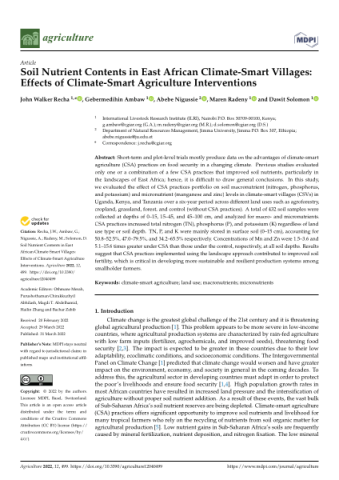Abstract
Short-term and plot-level trials mostly produce data on the advantages of climate-smart agriculture (CSA) practices on food security in a changing climate. Previous studies evaluated only one or a combination of a few CSA practices that improved soil nutrients, particularly in the landscapes of East Africa; hence, it is difficult to draw general conclusions. In this study, we evaluated the effect of CSA practices portfolio on soil macronutrient (nitrogen, phosphorus, and potassium) and micronutrient (manganese and zinc) levels in climate-smart villages (CSVs) in Uganda, Kenya, and Tanzania over a six-year period across different land uses such as agroforestry, cropland, grassland, forest, and control (without CSA practices). A total of 432 soil samples were collected at depths of 0–15, 15–45, and 45–100 cm, and analyzed for macro- and micronutrients. CSA practices increased total nitrogen (TN), phosphorus (P), and potassium (K) regardless of land use type or soil depth. TN, P, and K were mainly stored in surface soil (0–15 cm), accounting for 50.8–52.5%, 47.0–79.5%, and 34.2–65.5% respectively. Concentrations of Mn and Zn were 1.5–3.6 and 5.1–15.6 times greater under CSA than those under the control, respectively, at all soil depths. Results suggest that CSA practices implemented using the landscape approach contributed to improved soil fertility, which is critical in developing more sustainable and resilient production systems among smallholder farmers.

